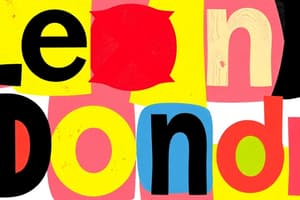Podcast
Questions and Answers
List Ehri's 4 phases of word recognition development?
List Ehri's 4 phases of word recognition development?
- Pre-alphabetic phase 2. Partial alphabetic phase 3. Full alphabetic phase 4. Consolidated alphabetic phase
Which of the following describes the pre-alphabetic phase?
Which of the following describes the pre-alphabetic phase?
- Limited connections between letters and sounds
- Knowledge of the alphabet and sound-symbol relationship
- Recognition of logos from familiar brands (correct)
- Complete connections between letters and phonemes
Which activity is suggested for the pre-alphabetic phase?
Which activity is suggested for the pre-alphabetic phase?
- Decode CVC words
- Identify words with the same initial sounds
- Cut out familiar logos and write brand names (correct)
- Introduce sight words
What is notable about the partial alphabetic phase?
What is notable about the partial alphabetic phase?
What would be an example of a confusion a child might make in the partial alphabetic phase?
What would be an example of a confusion a child might make in the partial alphabetic phase?
In the full alphabetic phase, how are words read?
In the full alphabetic phase, how are words read?
What activity is recommended for the full alphabetic phase?
What activity is recommended for the full alphabetic phase?
In the consolidated alphabetic phase, children process sight words as individual units.
In the consolidated alphabetic phase, children process sight words as individual units.
What is an example of how children process words in the consolidated alphabetic phase?
What is an example of how children process words in the consolidated alphabetic phase?
What activity is suggested for the consolidated alphabetic phase?
What activity is suggested for the consolidated alphabetic phase?
Flashcards
Pre-alphabetic Phase
Pre-alphabetic Phase
Word recognition based on context, not letter-sound relationships.
Partial Alphabetic Phase
Partial Alphabetic Phase
Partial connections between letters and sounds; limited phonemic awareness.
Full Alphabetic Phase
Full Alphabetic Phase
Complete links between letters and sounds; accurate reading, memorized sight words.
Consolidated Alphabetic Phase
Consolidated Alphabetic Phase
Signup and view all the flashcards
Pre-alphabetic intervention
Pre-alphabetic intervention
Signup and view all the flashcards
Partial Alphabetic intervention
Partial Alphabetic intervention
Signup and view all the flashcards
Full Alphabetic intervention
Full Alphabetic intervention
Signup and view all the flashcards
Consolidated Alphabetic intervention
Consolidated Alphabetic intervention
Signup and view all the flashcards
Word Recognition Phases
Word Recognition Phases
Signup and view all the flashcards
Phonemic Awareness
Phonemic Awareness
Signup and view all the flashcards
Study Notes
Ehri's 4 Phases of Word Recognition Development
- Phases include: Pre-alphabetic, Partial Alphabetic, Full Alphabetic, and Consolidated Alphabetic.
Pre-alphabetic Phase
- Knowledge of the alphabet is absent; recognition is based on context rather than sound-symbol relationships.
- Example: Young children can "read" logos of familiar brands through visual recognition instead of letter understanding.
- Activities for intervention include:
- Cutting out familiar logos from magazines and labeling them.
- Locating logos in the classroom to highlight initial letters/sounds.
- Using phonic faces to enhance connections.
Partial Alphabetic Phase
- Initial connections between written words and their pronunciations form, relying on some knowledge of letters and sounds.
- Limited phonemic awareness leads to partial connections; for instance, recognizing "spoon" as "skin."
- Activities for intervention include:
- Creating CVC words on sentence strips and manipulating sounds.
- Identifying words with shared initial or final sounds.
- Using phonic faces to strengthen sound-letter associations.
Full Alphabetic Phase
- Establishes complete connections between letters in spelling and sounds in pronunciations, leading to accurate reading.
- Sight words are stored fully in memory, reducing confusion with similarly spelled words.
- Example of complete awareness: recognizing "S-W-EE-T."
- Activities for intervention include:
- Introducing and decoding sight words, CVC, and multisyllabic words.
- Working on blends to enhance decoding skills.
- Utilizing phonic faces for understanding short and long vowel relationships.
Consolidated Alphabetic Phase
- Children learn a larger set of sight words, allowing recognition of words as complete units.
- Example: The word "sweet" may be processed as two units: "sw" and "eet."
- Activities for intervention include:
- Introducing more advanced sight words appropriate for grade level.
- Demonstrating morphological changes to words for tense or meaning alterations.
- Showing how word forms can change, facilitating deeper understanding of language structure.
Studying That Suits You
Use AI to generate personalized quizzes and flashcards to suit your learning preferences.




